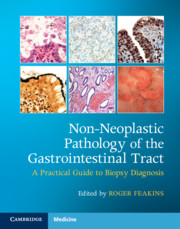Book contents
- Non-Neoplastic Pathology of the Gastrointestinal Tract
- Non-Neoplastic Pathology of the Gastrointestinal Tract
- Copyright page
- Dedication
- Contents
- Preface
- Acknowledgements
- Contributors
- Chapter 1 The Value of Gastrointestinal Biopsy
- Chapter 2 Gastrointestinal Involvement by Systemic Disease
- Chapter 3 Radiation and the Gastrointestinal Tract
- Chapter 4 Transplantation, Immunodeficiency, and Immunosuppression
- Chapter 5 Drug-Induced Gastrointestinal Disease
- Chapter 6 Gastrointestinal Ischemia and Vascular Disorders
- Chapter 7 Paediatric Conditions
- Chapter 8 Gastrointestinal Dysplasia
- Chapter 9 Normal Oesophageal, Gastric and Duodenal Mucosa
- Chapter 10 Histology of Gastroesophageal Reflux Disease and Barrett’s Oesophagus
- Chapter 11 Infections of the Oesophagus and Rare Forms of Oesophagitis
- Chapter 12 Assessment of Gastric Biopsies
- Chapter 13 Types of Gastritis
- Chapter 14 Duodenitis
- Chapter 15 Coeliac Disease
- Chapter 16 Inflammatory Bowel Disease and the Upper Gastrointestinal Tract
- Chapter 17 Normal Lower Gastrointestinal Mucosa
- Chapter 18 Infectious Disorders of the Lower Gastrointestinal Tract
- Chapter 19 Jejunitis and Ileitis
- Chapter 20 Microscopic Colitis
- Chapter 21 Inflammatory Bowel Disease Diagnosis
- Chapter 22 Mimics of Inflammatory Bowel Disease
- Chapter 23 Complications of Inflammatory Bowel Disease
- Chapter 24 Approach to Reporting Inflammatory Bowel Disease Biopsies
- Chapter 25 Ileal Pouch Anal Anastomosis
- Chapter 26 Diverticular Disease, Mucosal Prolapse, and Related Conditions
- Chapter 27 Non-Neoplastic Diseases of the Anal Canal
- Index
- References
Chapter 12 - Assessment of Gastric Biopsies
Published online by Cambridge University Press: 06 June 2020
- Non-Neoplastic Pathology of the Gastrointestinal Tract
- Non-Neoplastic Pathology of the Gastrointestinal Tract
- Copyright page
- Dedication
- Contents
- Preface
- Acknowledgements
- Contributors
- Chapter 1 The Value of Gastrointestinal Biopsy
- Chapter 2 Gastrointestinal Involvement by Systemic Disease
- Chapter 3 Radiation and the Gastrointestinal Tract
- Chapter 4 Transplantation, Immunodeficiency, and Immunosuppression
- Chapter 5 Drug-Induced Gastrointestinal Disease
- Chapter 6 Gastrointestinal Ischemia and Vascular Disorders
- Chapter 7 Paediatric Conditions
- Chapter 8 Gastrointestinal Dysplasia
- Chapter 9 Normal Oesophageal, Gastric and Duodenal Mucosa
- Chapter 10 Histology of Gastroesophageal Reflux Disease and Barrett’s Oesophagus
- Chapter 11 Infections of the Oesophagus and Rare Forms of Oesophagitis
- Chapter 12 Assessment of Gastric Biopsies
- Chapter 13 Types of Gastritis
- Chapter 14 Duodenitis
- Chapter 15 Coeliac Disease
- Chapter 16 Inflammatory Bowel Disease and the Upper Gastrointestinal Tract
- Chapter 17 Normal Lower Gastrointestinal Mucosa
- Chapter 18 Infectious Disorders of the Lower Gastrointestinal Tract
- Chapter 19 Jejunitis and Ileitis
- Chapter 20 Microscopic Colitis
- Chapter 21 Inflammatory Bowel Disease Diagnosis
- Chapter 22 Mimics of Inflammatory Bowel Disease
- Chapter 23 Complications of Inflammatory Bowel Disease
- Chapter 24 Approach to Reporting Inflammatory Bowel Disease Biopsies
- Chapter 25 Ileal Pouch Anal Anastomosis
- Chapter 26 Diverticular Disease, Mucosal Prolapse, and Related Conditions
- Chapter 27 Non-Neoplastic Diseases of the Anal Canal
- Index
- References
Summary
The recognition of specific oesophageal infections and the distinction between gastro-oesophageal reflux disease and rarer forms of oesophagitis are key tasks for gastrointestinal pathologists reading mucosal biopsies. Infections can involve the oesophagus either primarily or as part of a wider process. This chapter highlights their features, discussing in detail the common infections including herpes simplex, cytomegalovirus, and Candida, and summarises the features of the rarer ones. A few additional types of oesophagitis have emerged recently, including eosinophilic oesophagitis and lymphocytic oesophagitis. This chapter reviews the recent literature and will discuss the controversies surrounding some of these new entities. There is an emphasis on the need for correlation between clinical/endoscopic information and microscopic appearances, and there is discussion of supplementary special studies including immunohistochemistry where relevant.
Keywords
- Type
- Chapter
- Information
- Non-Neoplastic Pathology of the Gastrointestinal TractA Practical Guide to Biopsy Diagnosis, pp. 179 - 185Publisher: Cambridge University PressPrint publication year: 2020



